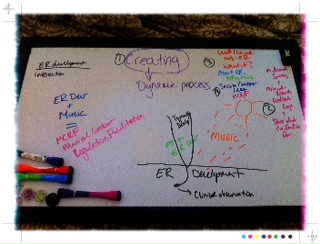It has officially been more than two weeks since I have last updated my blog! Yikes!
It has been quite a productive two weeks, though. I’ve spent the majority of the time making progress on my scholarly work. This is an exciting stage for me—many of my ideas, readings, and writings are finally starting to gel as I work on formulating the conceptual framework for my dissertation and subsequent research line.
A significant part of this research journey has involved time. Taking time to read, time to discuss, time to write, time to contemplate and reflect.
Another significant part of this journey has involved incorporating a variety of processing strategies. Having multiple ways of processing information invites multiple types of reflections and often provides multiple insights and ways to integrate information.
This is what I would like to share with you, 10 strategies for processing big ideas. In my case, these are helping me organize and integrate my developing research line. But these strategies are not restricted to scholarly work—they can translate to other “big ideas,” like business plans, yearly professional goals, presentation preparations, and marketing strategies. My suggestion for you is that you allow yourself time to incorporate multiple ways of processing as they allow for multiple ways of knowing and understanding.
Here are my 10 strategies for processing the big ideas:
- Draw it out. One of the best investments I made was purchasing a white board. This is my brainstorming medium, my outlet for divergent thinking. It helps me find common themes and is my go-to resource for the initial integration and organization of my big idea.
- Make a table. When it comes to organizing information, I love to make a table. It allows me, even forces me, to be clear about what information fits where and helps me see how different themes and ideas are related to each other.
- Sleep on it. Your brain needs a break. It needs time to percolate and process. Some of my best “ah-ha!” moments come in the morning after I have allowed myself a break from work and allowed my mind to digest what I’m working on.
- Talk it out. Napolean Hill’s Think and Grow Rich is a standard business success book. One of the concepts he writes about is that of the mastermind group, a gathering of like-minded people who, when focused on a single problem or idea, can pool their intellectual power to generate new and exciting ideas. Verbally processing your big idea may help generate new insights and perspectives.
- Write a paragraph. In presentations, I’ve alluded to the idea that sometimes you need to be like Nike and “just do it”. . . and the same holds true for this processing strategy. Sometimes it helps to force yourself to sit and write that first paragraph. Don’t worry about writing the perfect paragraph, just get yourself started my getting a rough draft on paper.
- Read. “Writing” isn’t limited to sitting at your computer and churning out paragraphs. Reading counts as writing, too. Plus, I encourage you to read outside of your profession. I’ve found that exposing myself to new authors and different types of writing styles improves my ability to organize and communicate complex ideas.
- Take a shower. I’ve blogged before about the perks of taking a shower. Automatic, mindless motoric activities like this allow your brain to wander and can provide an opportunity for an “ah-ha” moment.
- Re-read. As important as reading is, re-reading may be equally as important. You tend to notice new information and new ideas with each re-read.
- Take a break. Sometimes your mental breaks need to be longer than a night. It may need to last days or weeks. Taking a longer break helps you re-look at information with sharp, fresh eyes and can give you a new perspective on your big idea.
- Edit and revise. Every solid piece of writing goes through edits and revisions. The piece is made stronger with each pass-through. The same concept holds for your big idea. Don’t finish it on one pass. Go back, re-read, edit, and revise. And repeat.



 orcid.org/0000-0001-8665-1493
orcid.org/0000-0001-8665-1493






{ 2 comments… read them below or add one }
I use the white board too – I find that in moments when I’m not sure what to work on/what to do next I can take a look and refocus. Most of my best ideas come when exercising – so if I’m stuck I’ll go for a bike ride. Can’t wait to read your research.
Thanks, Blythe! And I completely agree about the exercising and how that can get the creative juices flowing, so to speak. By the way . . . you’ll get to read the start of my research line in the upcoming issue of Journal of Music Therapy! Yay! 🙂 ~Kimberly
You must log in to post a comment.